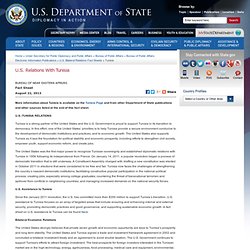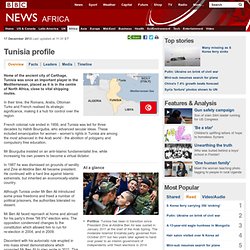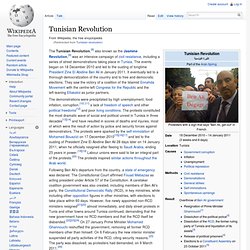

Tunisia. Tunisia Lonely Planet. Tunisia- US Dept of State. More information about Tunisia is available on the Tunisia Page and from other Department of State publications and other sources listed at the end of this fact sheet.

Tunisia is a strong partner of the United States and the U.S. Government is proud to support Tunisia in its transition to democracy. In this effort, one of the United States’ priorities is to help Tunisia provide a secure environment conducive to the development of democratic institutions and practices, and to economic growth. The United States also supports Tunisia as it lays the foundation for political stability and economic prosperity, including efforts to strengthen civil society, empower youth, support economic reform, and create jobs.
The United States was the first major power to recognize Tunisian sovereignty and established diplomatic relations with Tunisia in 1956 following its independence from France. U.S. Bilateral Economic Relations Tunisia's Membership in International Organizations Bilateral Representation. Tunisia. 17 December 2013Last updated at 11:31 ET Home of the ancient city of Carthage, Tunisia was once an important player in the Mediterranean, placed as it is in the centre of North Africa, close to vital shipping routes.

In their time, the Romans, Arabs, Ottoman Turks and French realised its strategic significance, making it a hub for control over the region. French colonial rule ended in 1956, and Tunisia was led for three decades by Habib Bourguiba, who advanced secular ideas. These included emancipation for women - women's rights in Tunisia are among the most advanced in the Arab world - the abolition of polygamy and compulsory free education.
Mr Bourguiba insisted on an anti-Islamic fundamentalist line, while increasing his own powers to become a virtual dictator. Continue reading the main story Politics: Tunisia has been in transition since President Zine al-Abidine Ben Ali was ousted in January 2011 at the start of the Arab Spring. Country profiles compiled by BBC Monitoring. Tunisia New York Times. Tunisian revolution. The Tunisian Revolution,[8] also known as the Jasmine Revolution,[9] was an intensive campaign of civil resistance, including a series of street demonstrations taking place in Tunisia.

The events began on 18 December 2010 and led to the ousting of longtime President Zine El Abidine Ben Ali in January 2011. It eventually led to a thorough democratization of the country and to free and democratic elections. They saw the victory of a coalition of the Islamist Ennahda Movement with the centre-left Congress for the Republic and the left-leaning Ettakatol as junior partners. The demonstrations were precipitated by high unemployment, food inflation, corruption,[10] [11] a lack of freedom of speech and other political freedoms[12] and poor living conditions.
Following further public protests, Ghannouchi himself resigned on 27 February, and Beji Caid el Sebsi became Prime Minister; two other members of the Interim Government resigned on the following day. Naming[edit] Background[edit] World Factbook. Tunisia. Tunisia (US i/tuːˈniːʒə/ too-NEE-zhə or UK /tjuːˈnɪziə/ tew-NIZ-i-ə; Arabic: تونس Tūnis pronounced [ˈtuːnɪs]; French: Tunisie;[Notes 1] Berber: ⵜⵓⵏⴻⵙ), officially the Tunisian Republic (though often referred to in English as the "Republic of Tunisia";[8] Arabic: الجمهورية التونسية al-Jumhūriyyah at-Tūnisiyyah; French: République tunisienne; Berber: ⵜⴰⴳⴷⵓⴷⴰ ⵏ ⵜⵓⵏⴻⵙ) is the northernmost country in Africa[Notes 2] and, at almost 165,000 square kilometres (64,000 sq mi) in area, the smallest country in the Maghreb region of North Africa.

It is bordered by Algeria to the west, Libya to the southeast and the Mediterranean Sea to the north and east. As of 2013, its population is estimated at just under 10.8 million.[3] Its name is derived from its capital city, Tunis, located on the country's northeast coast. Geographically, Tunisia contains the eastern end of the Atlas Mountains and the northern reaches of the Sahara desert. Much of the rest of the country's land is fertile soil.